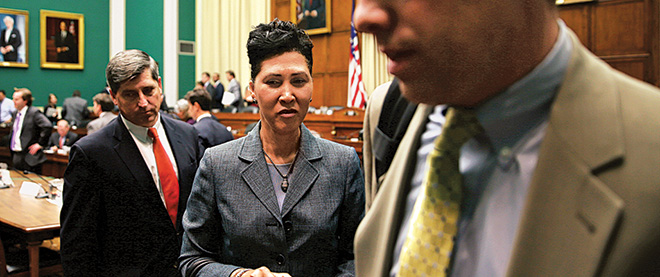The Montreal firm behind the Obamacare website woes
Lawmakers blame CGI, but investors see success
Alex Wong / Getty Images
Share

When Montreal’s CGI Group was picked to lead the $400-million development of America’s online health insurance marketplace—the flagship of U.S. President Barack Obama’s controversial health care plan—employees were treated to a seminar on how they weren’t just building another website, but “a system that will probably have an impact on your grandparents and eventually your parents and, if you’re fortunate to live long enough, on a system that will impact on you,” Cheryl Campbell, senior vice-president of CGI Federal, a U.S. unit of CGI, told an interviewer in February.
That vision stands in stark contrast to the picture Campbell painted last week when she was hauled before the U.S. Congress to explain the online exchange’s disastrous rollout earlier this month. Shortly after CGI’s healthcare.gov debuted on Oct. 1, thousands of users complained they found only blank screens and error messages when they tried to log on. Officials blamed the problems on a surge of traffic that had overloaded the site. Campbell told a congressional hearing that CGI bore no responsibility, blaming the troubles instead on a complicated network of contractors, and the federal government’s decision to launch the website before it had been properly tested. “From a CGI perspective, our portion of the application worked as designed,” she said.
Still, the fiasco has left a black mark on CGI, a company that has kept a low public profile, even as it has grown into a $10-billion international technology conglomerate with a knack for embedding itself into the culture of its customers, many of them governments. Government contracts represented 40 per cent of CGI’s nearly $5 billion in revenue last year. More than $1 billion of its revenues came from Canada. While it’s hardly a household name, CGI says it provides services to 95 different federal government departments and Crown corporations, as well as most provinces and both the Canadian and Quebec pension plans.
In the U.S., conservative commentators were quick to paint CGI, which has extensive agreements with Health Canada and most provincial health agencies, as the technical architect behind Canada’s socialized health care system. Several noted its ongoing legal battle with the Ontario government over its decision to scrap work on an electronic diabetes registry last fall, alleging CGI was taking too long.
“It is just an awful website built by people who really are specializing in getting government contracts and not necessarily delivering technical expertise,” software expert Luke Chung told MSNBC last week, of healthcare.gov.
But while the company has suddenly become the Canadian face of America’s fractious health care debate, investors have shrugged off the scandal as a minor setback. After an initial drop, CGI’s shares are sitting around $34, up nearly 50 per cent since the start of the year. A TD Securities report last week suggests investors aren’t holding CGI entirely to blame for the website’s problems. “There is no indication that CGI failed to deliver on its commitments,” it said, adding the contract represents less than three per cent of the company’s annual revenues.
If anything, the scandal has proven just how successful Canada’s largest technology firm has become in securing government work. Shortly after Obama apologized for the site’s technical problems, the government announced it was assembling an “A Team” of the country’s best technical minds to fix the website—once again tapping CGI to lead the effort.